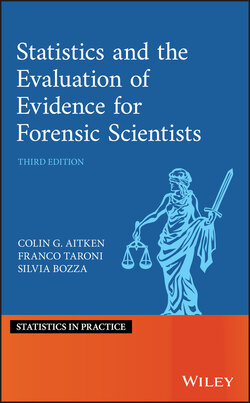Читать книгу Statistics and the Evaluation of Evidence for Forensic Scientists - Franco Taroni - Страница 12
Foreword
ОглавлениеUncertainty affects nearly everything we do. Virtually every decision we make involves uncertainty of one kind or another. However, uncertainty does not come naturally to people's minds. Whenever we can (and sometimes when we can't), we substitute an imagined certainty that we find more comfortable and easier to plan against.
Statistics offers tools to deal with uncertainty, principally through probability. There are many models and methods in a statistician's toolkit. Which to use when, and how to create more when necessary are the typical tasks facing users of statistical methods. Every application of statistics has to be sensitive to the institutional context in which the problem arises. In the case of forensic evidence, the institutional structure includes both the organizations for which forensic scientists work and the legal structures to which they ultimately report.
The stakes are high in forensic work, as someone's liberty and/or life is typically at stake. As a consequence, a careful consideration of the uncertainties involved is morally imperative. Doing responsible work under these circumstances requires that sources of uncertainty be identified, quantified, and reported, both truthfully and effectively. The first task is to figure out what the principal sources of uncertainty are. For example, DNA analyses often report tiny probabilities that someone other than the defendant would have the same configuration of alleles as those found at a crime scene. But this probability is premised on the assumption that the crime scene and laboratory work have been error‐free. If the probability of contamination from one of these sources is one in a thousand, contamination is the dominant source of uncertainty, and should be reported.
The second task is quantification. Depending on the source of uncertainty, this can be daunting. Records can be examined to find how often collection and lab errors leading to contamination have been discovered, for example, but one is left wondering how many others there may have been that were not discovered. Experiments can help, particularly blind testing in which the technicians do not know they are being tested. Our ability to conduct such tests is in its infancy.
Finally, there is the question of how to report the uncertainty in forensic analyses. The legal structure does not necessarily welcome uncertainty, as it complicates the task of the finders‐of‐facts, whether judges or juries. But it is incumbent on forensic scientists to be both thoughtful and truthful in conveying to the parties and to the court the uncertainties that lurk behind their findings. A shrill proclamation of infallibility does not advance justice.
The legal context has other implications for which statistical methods are most apt. A case involves the innocence and guilt of a particular defendant or group of defendants, faced with a particular set of evidence. As such, methods that rely for justification on long‐run frequencies seem beside the point. One has to do the best one can in this specific instance. Therefore, subjective probability, which focuses on the specifics of the case without embedding it in a hypothetical infinite string of superficially similar cases, is more suited to forensic applications. What are the practical implications of such a choice? It permits forensic scientists to summarize their opinions in a number, such as ‘The probability of a correspondence between the latent print at the crime scene and that of the defendant if the defendant is not the source of the crime scene print is 1%’. That's all very well as a statement of personal belief, but if anyone else is to take such a statement seriously, it must be accompanied by reasons. What assumptions were made in the analysis? What considerations make those assumptions plausible? If other plausible assumptions were made, what would their consequences be? Subjective (or personal) probability is a way of conveying one's opinion in a precise manner, but whether anyone else should pay attention to it depends on the persuasiveness of the arguments that go with it.
The book, Statistics and the Evaluation of Evidence for Forensic Scientists aims to assist forensic scientists and others to do this work well. That it is now in its third edition reflects the success of the previous editions, summarizing what had been found. That a new edition is needed reflects the new thinking and new work that has been done in the last decade and a half. As more progress is made, no doubt further editions will be needed. This edition shows what has been accomplished, and charts the way forward.
J. B. Kadane
December 2019
